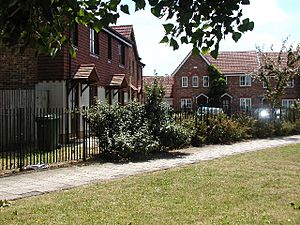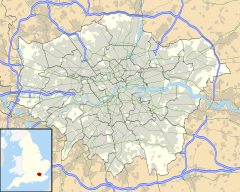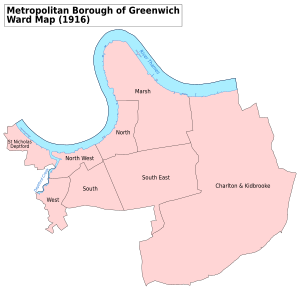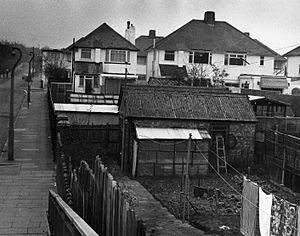Kidbrooke facts for kids
Quick facts for kids Kidbrooke |
|
|---|---|
 Nelson Mandela Road, Kidbrooke |
|
| Population | 14,300 (2011 Census: Kidbrooke with Hornfair Ward) |
| OS grid reference | TQ413760 |
| • Charing Cross | 7.5 mi (12.1 km) WNW |
| London borough | |
| Ceremonial county | Greater London |
| Region | |
| Country | England |
| Sovereign state | United Kingdom |
| Post town | LONDON |
| Postcode district | SE3, SE9 |
| Dialling code | 020 |
| Police | Metropolitan |
| Fire | London |
| Ambulance | London |
| EU Parliament | London |
| UK Parliament |
|
| London Assembly |
|
Kidbrooke is a place in south-east London, England. It is part of the Royal Borough of Greenwich. Kidbrooke is about 7.5 miles (12 km) south-east of Charing Cross. It is also north-west of Eltham.
The name Kidbrooke comes from the Kyd Brook. This is a small river that flows from Orpington to Lewisham. There, it joins the River Quaggy. The Kyd Brook is also a branch of the River Ravensbourne.
Contents
Kidbrooke's Past
The name Kidbrooke comes from an old Anglo-Saxon word. It means 'the brook where kites (a type of bird) were seen'. This suggests that no one lived in the area when it was named. Kidbrooke had three streams and heavy, wet clay soil. This made it hard for Saxon people to settle there.
By the late 1000s or 1100s, Kidbrooke had a church. It likely had a small number of people living there. However, this community did not last. By 1428, the church had no priest. By 1494, it was falling apart.
Kidbrooke stayed a farming area until 1895. That's when Kidbrooke railway station opened. After the 1930s, the area grew a lot. This was especially true after the Rochester Way road was built.
Homes in Kidbrooke
Many homes in Kidbrooke were built in the 1920s and 1930s. These houses are part of the Kidbrooke Park Estate. This estate is located between Shooters Hill and Rochester Way.
A large RAF storage base used to be near Kidbrooke railway station. It was called RAF Kidbrooke. In 1965, the government gave most of this land to the Greater London Council. They wanted to build new homes there. The Ferrier Estate was built starting in 1968. It was meant to be a great housing project. But it became one of London's largest and most struggling council housing areas.
The Ferrier Estate was taken down in 2012. It has been rebuilt as Kidbrooke Village. This new development will have 5,300 homes.
What to See in Kidbrooke
South of where the Ferrier Estate used to be is Sutcliffe Park. This park has a lake. The lake helps prevent floods. It was made by bringing the Kyd Brook river back above ground. The river had been flowing in underground pipes until 2006.
Rochester Way is a road that follows an old country lane. It was built to help traffic avoid Shooters Hill. Now, Rochester Way itself has a bypass. This is a dual carriageway road, part of the A2 road. It was built in the 1980s over most of Kidbrooke Green. A small part of this open land is now Kidbrooke Green Park. Next to it is a small nature reserve. The nature reserve is managed by Greenwich Council. You can see it, but you cannot go inside.
Not much is left of the old RAF base. A few buildings remain north of the railway line. They are used by the National Maritime Museum for storage. Some have been removed for a new building. This new building is the Prince Philip Maritime Collections Centre. It opened in 2019.
To the west of this area is Thomas Tallis School. It is built on another part of the former RAF base. This site was once a prisoner-of-war camp. It was also a barrage balloon centre and a military language school.
Getting Around Kidbrooke
Train Travel
Kidbrooke railway station offers train services. These are run by Southeastern. You can travel to London Victoria, London Charing Cross, and London Cannon Street. Trains also go to Dartford and Slade Green.
Bus Services
Kidbrooke has several London Buses routes. These include routes 132, 178, 286, 335, 386, and B16. These buses connect Kidbrooke to places like Bexleyheath, Blackheath, Eltham, Greenwich, Lewisham, North Greenwich, Sidcup, Welling, and Woolwich.
Main Roads
The A2 road gives Kidbrooke quick access to other major roads. These include the London Inner Ring Road, the South Circular Road, and the M25 motorway.
Schools in Kidbrooke
Primary Schools
- Wingfield School
- Kidbrooke Park
- Holy Family R.C.
- Henwick Primary School
- Ealdham Primary School
Secondary Schools
- The Halley Academy — This school opened in 1954 as Kidbrooke School. It was the first purpose-built comprehensive school in Britain. It became an academy in 2011 as Corelli College.
- Thomas Tallis School — This school opened in 1971.
Famous People from Kidbrooke
Some well-known people have lived in Kidbrooke. Comedian Jim Davidson grew up on Holburne Road. Interior designer Lawrence Llewelyn Bowen lived on Kidbrooke Park Road until 2004. Singer Sandie Shaw also lived here. Former AFC Bournemouth player Junior Stanislas was born in Kidbrooke.




